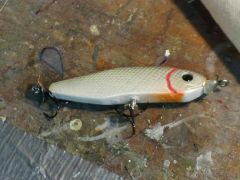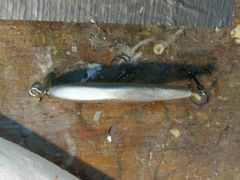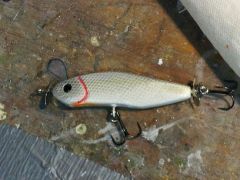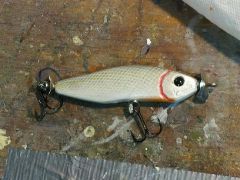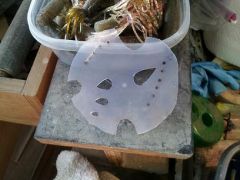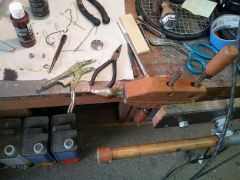-
Posts
14,726 -
Joined
-
Last visited
-
Days Won
364
Content Type
Profiles
Articles
TU Classifieds
Glossary
Website Links
Forums
Gallery
Store
Everything posted by mark poulson
-
PVC trimboard, 3 1/2" long, 7/8" tall, 7/16" thick, 21 grams including 7 grams ballast. All Createx and Wildlife colors, with pearl silver as the scale color. I put the ballast in vertical holes, and moved it so 1/3 of the ballast lead (3/16 lead wire) is above the centerline between the front screw eye and the back screw eye. 2.3 grams behind the middle swivel/hook hanger, the rest in three holes in front of that hook hanger spread 2.3 grams, 2 grams, and the last .6 gram centered on the centerline. The lure falls just slightly nose down, and, because the ballast is so high, it wobbles on the fall, like a Red Eye Shad. I made this larger from top to bottom than my others, and heavier, because I wanted it to get down deep more quickly, and to have a larger presence in the deeper water. I made and finished this bait in 3 hours today, and have already dipped it once in AC1315, heat set so I could put the hardware on after another hour. I'll find out this weekend if it works, or if I'm just dreaming again. Hahaha
-
PVC trimboard, 3 1/2" long, 7/8" tall, 7/16" thick, 21 grams including 7 grams ballast. All Createx and Wildlife colors, with pearl silver as the scale color. I put the ballast in vertical holes, and moved it so 1/3 of the ballast lead (3/16 lead wire) is above the centerline between the front screw eye and the back screw eye. 2.3 grams behind the middle swivel/hook hanger, the rest in three holes in front of that hook hanger spread 2.3 grams, 2 grams, and the last .6 gram centered on the centerline. The lure falls just slightly nose down, and, because the ballast is so high, it wobbles on the fall, like a Red Eye Shad. I made this larger from top to bottom than my others, and heavier, because I wanted it to get down deep more quickly, and to have a larger presence in the deeper water. I made and finished this bait in 3 hours today, and have already dipped it once in AC1315, heat set so I could put the hardware on after another hour. I'll find out this weekend if it works, or if I'm just dreaming again. Hahaha
-
PVC trimboard, 3 1/2" long, 7/8" tall, 7/16" thick, 21 grams including 7 grams ballast. All Createx and Wildlife colors, with pearl silver as the scale color. I put the ballast in vertical holes, and moved it so 1/3 of the ballast lead (3/16 lead wire) is above the centerline between the front screw eye and the back screw eye. 2.3 grams behind the middle swivel/hook hanger, the rest in three holes in front of that hook hanger spread 2.3 grams, 2 grams, and the last .6 gram centered on the centerline. The lure falls just slightly nose down, and, because the ballast is so high, it wobbles on the fall, like a Red Eye Shad. I made this larger from top to bottom than my others, and heavier, because I wanted it to get down deep more quickly, and to have a larger presence in the deeper water. I made and finished this bait in 3 hours today, and have already dipped it once in AC1315, heat set so I could put the hardware on after another hour. I'll find out this weekend if it works, or if I'm just dreaming again. Hahaha
-
PVC trimboard, 3 1/2" long, 7/8" tall, 7/16" thick, 21 grams including 7 grams ballast. All Createx and Wildlife colors, with pearl silver as the scale color. I put the ballast in vertical holes, and moved it so 1/3 of the ballast lead (3/16 lead wire) is above the centerline between the front screw eye and the back screw eye. 2.3 grams behind the middle swivel/hook hanger, the rest in three holes in front of that hook hanger spread 2.3 grams, 2 grams, and the last .6 gram centered on the centerline. The lure falls just slightly nose down, and, because the ballast is so high, it wobbles on the fall, like a Red Eye Shad. I made this larger from top to bottom than my others, and heavier, because I wanted it to get down deep more quickly, and to have a larger presence in the deeper water. I made and finished this bait in 3 hours today, and have already dipped it once in AC1315, heat set so I could put the hardware on after another hour. I'll find out this weekend if it works, or if I'm just dreaming again. Hahaha
-
I just use the usual c__p I have lying around.
-
I start with opaque white, and add some trans. yellow to warm it up. A drop or two of gold metallic browns it slightly, but not too much.
-
I just finished in my garage, and one of the things I did was check my foiled bait that was dipped twice. I found I could feel the foil seam on one side that I hadn't felt before, but the other seams were still smooth. I couldn't feel them at all. So, either the AC1315 continued to cure and shrink a little, or I missed it the first time I checked, and the seam wasn't smooth the last time. Sorry for the confusion.
-
I would contact the manuf. They were very helpful when I called them. http://www.directcolors.com/product/ac-1315-high-gloss-concrete-sealer/
-
That makes sense. I throw the fat Ika a lot, and that is a fat piece of plastic. I found the perfect hook for center rigging it was a Mustad Mega Lite 5/0. It was a needle point, but it had enough bite that if I got bit, counted to three and then set, I stuck most of the fish in the roof of the mouth, or somewhere on the inside of the mouth. Unfortunately, Mustad discontinued that hook. It was a lite wire hook that was still tempered strong, and had a deep bite. I'm searching now for a replacement.
-
Free advice is generally only worth what you pay for it, but this is mine: Go to a CPA. Pay him/her to tell you what it will cost to operate a legitimate lure making business, and what the risks are. It is their job to know this stuff, and their advice actually means something.
-
I found that it cured for me in three minutes, with me turning the lure every 30+- seconds. Someone here posted that taking it out and turning it would help keep the Solarez from fogging up, and I've followed their advice. So far, I've had very slight fogging only on black or really dark backed lures. I have never tried just letting one hang in the light for three seconds without turning. Since the entire interior of my light box is reflective, it would probably cure that way, but I haven't done it myself.
-
I just checked the bill on the AC1315 dipped wiggle wart that I fished hard Saturday. The coating on the bill held up fine. I couldn't even see marks from where it ground on the rocks. If I had dipped the same lure in the urethane I've used it would have peeled. Been there, done that. So I'll continue to coat the entire lure when I dip, until I begin to have failures. I do think heat setting the AC1315 really is the key, because it gets the solvent out of the entire layer before the top of the coating skins over, and traps solvent, slowing the curing process. That, and hanging the baits in front of a work light to keep them warm as they cure.
-
That was the big complaint when Owner first came out with their cutting point...it was supposed to open too big a hole on the way in, so fish could throw it more easily. Now Smalljaw says Gamakatsu, Owner, and Trokar all have cutting points, so is it really that bad? Of course, I won't pay for Trokar hooks anyway. To me, it's like buying a $.10 cup of coffee at Starbucks for $1.75.
-
Hahaha No secrets from you Bob! I do try to make my process as fast as possible, within reason. Maybe raising 5 kids has made me try to fit everything into what free time I've had. Maybe that's where the wham, bam thing comes in. Hahaha But I do have fun building and painting. Since I retired this year, I'm trying to learn to take more time with everything, and pay more attention to details. The latest fun thing for me was to try my hand at stenciling. I always shied away from it because my pressure regulator is in a very hard to reach place. But I bought a MAC valve that I put between my air hose and my quick disconnect, and, all of a sudden, pressure regulating is easy. So I've begun fooling around with stencils, which add time to my painting, but not a lot. I've also found that I can get a "fish it the next day" lure if I dip in AC1315, and dry it with a hair dryer like I do airbrush paint. It is completely clear, and it even protects painted bills, so far. I fished a crank with a painted bill hard Saturday, grinding it over the rocks a lot, and, so far, it's held up. I've moved away from Solarez, since I've found AC1315. Fickle, I know.
-
I hold my jigs by the line tie when I dip, and make sure the eyes are clear before I cure them at 250 for 30 minutes, hanging by the hook in my toaster oven. As long as I don't over paint the jigs I don't have problems.
-
I use old, aluminum needle nose pliers that have semi-smooth jaws from long use, so it's not an issue for me. I actually have the jig hook line tie shape in the jaws from powder paint residue, and I use that to orient my jigs when I'm heating and painting them.
-
I've used 100% GE Silicone caulk in the past. It holds up just fine to the heat of soft plastics. Taking my time to get the entire master well covered with a thin film first, so it gets into all the details, was a key for me. Then I set it into my wooded mold box form, and filled the box up by pumping the caulk in with a caulking gun. I found going slowly was a real key to getting a good mold. I rehearsed every step in several dry runs, so I could see where the problems might arise before I began with the silcone.
-
Barry, To me they're phantom because they're translucent. A ghostly impressionist paint scheme. Geez, that sounds neat! If you figure out a way to make PVC clear, please let me know! Hahaha
-
Sounds great! Good luck!
-
If it's surface yellowing, a quick dip in acetone should remove it. If it's yellow all the way through, I haven't found a way to remove it.
-
I use 1 1/2" blue painters tape. I cut a piece about 3" long, and place it up against the nose on the top of the lure. I push the line tie wire up through the tape, and then wrap the tape over the tip of the bill and down back side of the bill, trying to get it to cover the same location near the nose as I do. Once I have the main bill covered, I cut a 1/4"X 1 1/2" strip of tape, cut that into two 3/4" lengths, and use those strips to mask the small triangle at each side of the bait's nose that aren't covered yet. I start by putting the first strip on top, covering that triangle, and then fold it over the edge of the bill and align it to cover the triangle on the bottom. For me, that's plenty. I used to try and get a perfect fit by cutting curves in the tape, but I soon found out that for me, this method is plenty good, and takes about two minutes a bait. For smaller bills, I wrap from side to side, not over the nose, and use the excess tape at the end of the bill for the side strips. I cut it off before I begin folding, so it is a nice, straight+- piece.
-
Makes total sense. I was just wondering if my letting the baits hang and drip before curing wound up making the Solarez thinner than brushing and turning. Either way, it's a great top coat for quick turnaround lures. I can build, paint, top coat, and fish the same day. I seldom do it like that, but it's totally doable. And I don't see the blush except on dark backs, and that is only occasionally. Must be my good, clean living!
-
Hahaha I'm not used to having time to spare, so most of my lure making is done with the fewest steps and the least time possible. Adding this kind of detail is not something I had planned on trying, but it is fun. I finally practiced and refined my method enough so that it only adds an extra 10 minutes per lure, but it does add another layer of fun to the whole process for me. Again, as a hobby builder, I look for cheap, quick, and doable from the things I have lying around. I'm sure there are better stencil materails, and painting processes. But, since I added a MAC valve from Iwata to my air brush, just before the quick disconnect at the brush itself, I'm able to do much more detail because of the added control it provides. Watching Michael Orinstein's video on how he paints was the reason I got the MAC valve, so it's all his fault!!!! Hahaha
-
Bob, I get far less or no white when I use my nail light, as opposed to setting the lures outside in the sun to cure. I also hang them, so the excess drips off back into the dipping jar. Maybe this makes the coating thinner than brushing and turning.
-




